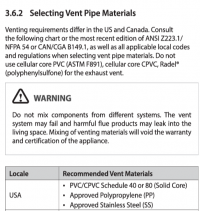No Soup for you
Registered User
I did a search couldnt find.
Sorry didny know whether to put in plumbing section or mech etc...
Did an inspection and the Navien tankless water heater is mounted on a sheet of OSB plywood. I am thinking probably not a great idea as it is combustible.
So i look up mounting instructions from Navien, no mention of this,
I call the technical dept they say not to be mounted on combustible material, he says its in the instructions. I cant find it...
I call back and I am on hold forever , so I try the "chat" thing from website, I specifically ask about OSB as its combustible, they say not to use OSB because it will not be strong enough to hold the unit which is BS.
I checked fuel gas code, refers back to plumbing code, Cant find anything about combustible material.
Am I missing something?
Should I let it go?
Any discussion?
Sorry didny know whether to put in plumbing section or mech etc...
Did an inspection and the Navien tankless water heater is mounted on a sheet of OSB plywood. I am thinking probably not a great idea as it is combustible.
So i look up mounting instructions from Navien, no mention of this,
I call the technical dept they say not to be mounted on combustible material, he says its in the instructions. I cant find it...
I call back and I am on hold forever , so I try the "chat" thing from website, I specifically ask about OSB as its combustible, they say not to use OSB because it will not be strong enough to hold the unit which is BS.
I checked fuel gas code, refers back to plumbing code, Cant find anything about combustible material.
Am I missing something?
Should I let it go?
Any discussion?


